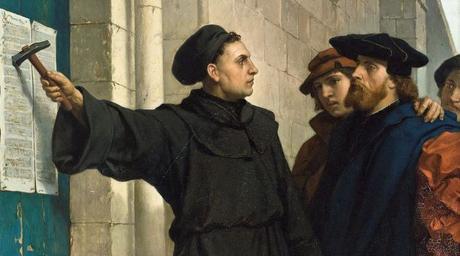
Republished by permission
November 1st is traditionally known as “All Saints’ Day” in the Western Christian calendar–a day to remember all of the faithful departed. The day (eve) before All Saints’ Day was “All Hallows’ (an older word for “saint) Eve.” Later, in a series of twists and turns (more reminiscent of the latest TV sitcom, rather than “normal” history) this Christian holiday devolved into our contemporary Halloween.
What is less known about this day is that it marks the moment an obscure German monk and college professor presented a list of religious concerns for a formal debate, unwittingly sparking one of the most momentous events in Western history–the Reformation.
Many in the conservative Protestant tradition resonate with Martin Luther’s bold stand to proclaim the truths of the Bible, and to resist the authoritarian forces of control. But what they forget are the true aims of Luther and the first generation of reformers.
Martin Luther did not mean to start the Reformation. As a “doctor” of theology, he was trying to start an academic discussion about common church practices, such as “indulgence preachers,” who were basically selling get-out-of-Purgatory-free cards. He initially had no intention of breaking ties with the Roman Catholic church.
Many factors led to what we now call the “Reformation.” The first was the rediscovery of Biblical Greek and Hebrew. Most of the Reformers were serious students of these languages, and the insights they gained from this Scriptural engagement fueled the momentous changes that many celebrate on Oct. 31.
The second factor was the cultural movement we call the “Renaissance.” At its most basic level, the Renaissance looked back to the artistic and literary achievements of ancient Greece and Rome. Cultural life blossomed, spawning artists such as da Vinci and Michelangelo, composers such as Palestrina, and authors such as Dante Alighieri. In northern Europe, the Renaissance took a more “bookish” turn. Sparked by Johannes Gutenberg’s invention of the movable-type printing press, northern Europeans could suddenly produce and exchange ideas quickly through the printed word. Towns like Basel in Switzerland became centers of scholarship and book-production. Erasmus of Rotterdam led this movement through his scholarship and his wit. With biting satire and vast learning, Erasmus criticized the many moral and spiritual failings of the Catholic Church.
However, in the ensuing conflict, Erasmus remained loyal to the Roman church, unlike many of his protégés. Johannes Oecolampadius worked closely with Erasmus in Basel, putting together the first printed edition of the Greek New Testament, as well as new editions of classic Christian thinkers and pastors like Gregory of Nyssa, John Chrysostom, and Basil of Caesarea. As Oecolampadius dove deeper into the original Greek and Hebrew of the Bible, he joined the ranks of the Reformers. Eventually, their devotion to God’s Word led them into sustained conflict with Roman church officials, and finally into a full-fledged “Reformation.”
These Reformers shared the goal of returning the church to a purity and fervency that they read about in the New Testament (in the original Greek) and in the church fathers (many of whom wrote in Greek). They did not want to reject all of previous church history—they saw themselves as truly “catholic,” in one sense of the original Latin word. Catholicus means “universal,” and the early Reformers tried to reform Christian worship and church practices according to what Christians had “universally” believed and practiced.
The Reformation began roughly 500 years ago. What many don’t realize, however, is that a similar reformation is occurring today, only not in the churches, but in the schools. Classical Christian schools, to be more specific.
Like the original Reformers, educators in the classical Christian school movement seek to train and equip the next generation of leaders who will boldly stand for the truth in their culture, churches, and homes. They seek to inspire students who will bravely challenge the status quo, motivated by what they see in Scripture. And they hope that students’ brief exposure to the Great Books, the Great Thinkers, and the classical languages like Latin and Greek will enable them to gain the wisdom and eloquence to lead a new Reformation.
Is it possible that by teaching students to stand on the shoulders of these intellectual giants, they, like the Reformers before them, will be able to steer the world down a completely different path than the one it is currently on?
For Further Reading
Getting the Reformation Wrong: Correcting Some Misunderstandings – James R. Payton, Jr.
Church History (vol. 2): From Pre-Reformation to the Present Day – John D. Woodbridge & Frank A. James III
An Introduction to Classical Education: A Guide for Parents – Dr. Christopher Perrin
Wisdom and Eloquence: A Christian Paradigm for Classical Learning – Robert Littlejohn & Charles T. Evans
The Liberal Arts Tradition: A Philosophy of Christian Classical Education – Ravi Jain & Kevin Clark
This post: Is a Second Reformation Unfolding in Front of Our Eyes? was originally published on Intellectual Takeout by Gregory Soderberg.
Advertisements
